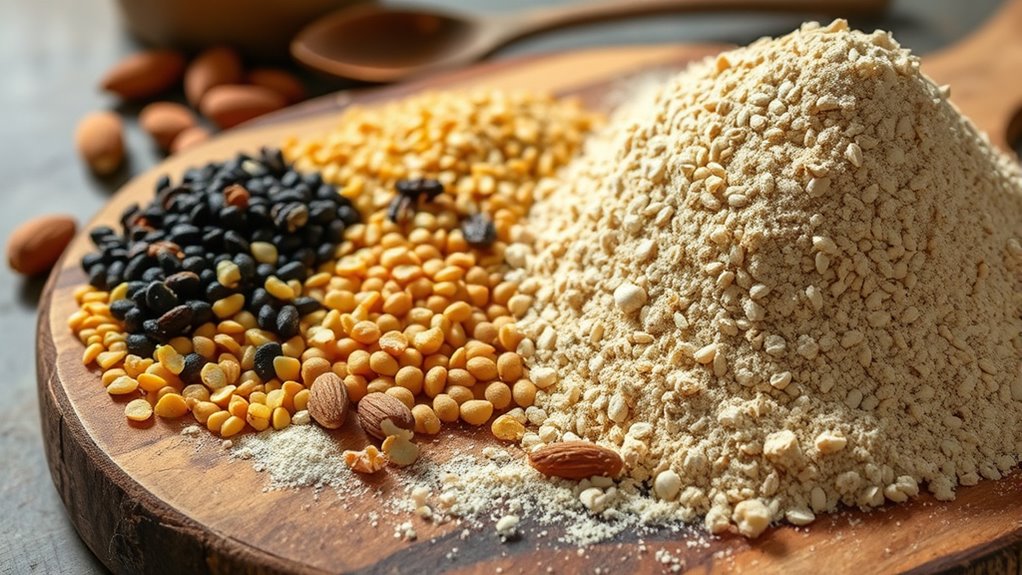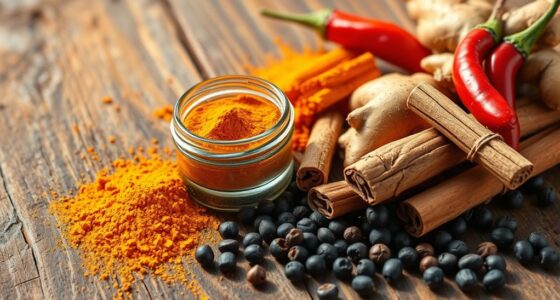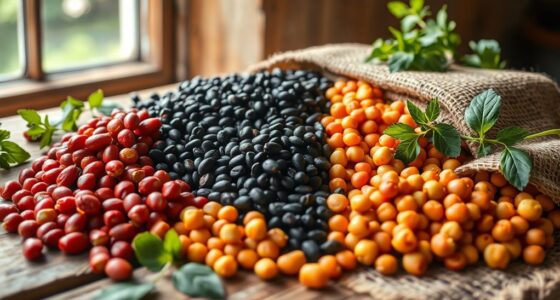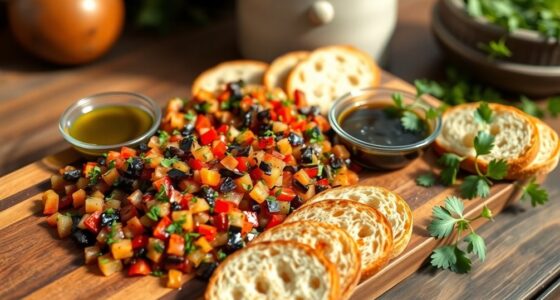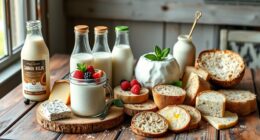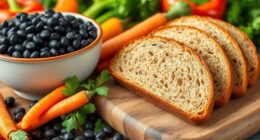In gluten-free baking, incorporating upcycled flours and ancient grains boosts flavor, nutrition, and sustainability. Upcycled flours from spent grains or leftover milling are nutrient-dense and add hearty textures, while ancient grains like teff and millet bring essential vitamins and antioxidants. Fermentation enhances digestibility and mineral absorption, making your baked goods healthier and tastier. Keep exploring to discover how these ingredients can transform your gluten-free recipes into wholesome, flavorful treats.
Key Takeaways
- Incorporating upcycled flours and ancient grains enhances the nutritional density and flavor of gluten-free baked goods.
- Fermentation with sourdough improves digestibility and nutrient availability in gluten-free recipes.
- Upcycled flours reduce waste, increase fiber and micronutrients, and support sustainable baking practices.
- Ancient grains offer diverse vitamins and antioxidants, enriching gluten-free baked products with complex flavors.
- Combining fermentation and alternative grains maximizes health benefits, improves mineral absorption, and creates wholesome, flavorful baked goods.

Have you ever wondered how to enjoy delicious baked goods without gluten? The secret lies in understanding the power of sourdough fermentation and exploring the unique grain nutrition profiles of ancient and upcycled flours. When you embrace sourdough fermentation, you reveal a natural process that not only improves the flavor and texture of gluten-free bread but also enhances digestibility. This method involves fermenting dough with wild yeast and bacteria, which breaks down complex carbohydrates and gluten proteins, making the final product easier on your digestive system. Even better, sourdough fermentation can increase the bioavailability of nutrients, giving you more of the vitamins and minerals your body craves from grains.
As you experiment with different flours, you’ll notice that upcycled options—such as spent grain flour from breweries or leftover grains from milling—bring sustainability into your baking. These flours often retain valuable nutrients that might otherwise go to waste, enriching your baked goods with fiber, protein, and micronutrients. Plus, they add a depth of flavor and a hearty texture that elevate your recipes beyond typical gluten-free options. Ancient grains like millet, teff, and amaranth also contribute unique grain nutrition profiles, offering a broad spectrum of vitamins, minerals, and antioxidants. Incorporating these grains into your baking not only diversifies your diet but also supports your health by providing complex carbs that sustain energy levels and promote gut health.
When you combine sourdough fermentation with these alternative grains, you’re creating a synergy that maximizes flavor and nutrition. The fermentation process helps break down phytates and other anti-nutrients found in these grains, making minerals like iron, zinc, and magnesium more accessible to your body. This is especially beneficial if you’re on a gluten-free diet, as it may improve your overall nutrient intake and digestion. Additionally, the tangy complexity of fermented dough can complement the nutty, earthy flavors of ancient grains and upcycled flours, resulting in baked goods that are as wholesome as they are delicious.
Frequently Asked Questions
Can Gluten-Free Flours Replace Wheat Flour in All Recipes?
You can’t always replace wheat flour with gluten-free substitutions in all recipes. Gluten-free flours, like almond or coconut, offer great baking versatility but often require adjustments in liquids and binders. Some baked goods need the elasticity gluten provides, so you might need to experiment or combine different gluten-free flours for the best results. Remember, not every recipe adapts perfectly, but with practice, you can achieve delicious, gluten-free alternatives.
Are Upcycled Flours More Nutritious Than Traditional Flours?
Upcycled flours pack a punch in nutrition, often surpassing traditional flours with their rich Nutritional benefits. They’re crafted from food scraps, making a huge Environmental impact by reducing waste and conserving resources. You’ll find these flours more nutrient-dense, offering vitamins, minerals, and fiber that support your health. So, yes, upcycled flours can be a smarter, eco-friendly choice that boosts your diet’s nutritional value.
How Do Ancient Grains Affect Baking Texture and Flavor?
Ancient grains add unique flavor profiles and texture variations to your baked goods. You’ll notice richer, nuttier tastes that enhance your recipes, while the grains’ natural texture can make bread or muffins more hearty and chewy. These grains often bring a depth of flavor and a satisfying bite, elevating your baking beyond standard options. Experimenting with ancient grains allows you to create more complex, flavorful, and interesting textures in your baked treats.
What Are the Best Storage Methods for Gluten-Free Flours?
Storing gluten-free flours is like keeping treasures safe—you’ll want to protect their freshness. Place your flours in airtight containers to prevent moisture and pests. For longer storage, keep them in the refrigerator or freezer, using airtight packaging to avoid odors. This method slows spoilage and maintains quality, ensuring your baking remains delicious and healthy. Remember, proper storage keeps your flour’s magic alive for all your gluten-free creations.
Are There Allergen Concerns With Ancient Grains and Upcycled Flours?
Yes, there are allergen concerns with ancient grains and upcycled flours. You should be aware of cross reactivity concerns, especially if you’re sensitive to gluten or other grains. Cross contamination risks are also present during processing and storage, which could introduce allergens. Always check labels carefully, choose certified gluten-free options when needed, and consider talking to your healthcare provider if you have specific allergies or sensitivities.
Conclusion
Embrace the possibilities of gluten-free baking—explore upcycled flours and ancient grains, ignite your creativity, and nourish your body. Let each ingredient inspire you, each bake challenge you, and each delicious result remind you of your resilience. With every loaf, every cookie, and every slice, you build a healthier, happier future. Bake boldly, experiment endlessly, and savor the joy that comes from transforming simple ingredients into extraordinary creations. Your gluten-free journey is just beginning—keep baking, keep thriving.
